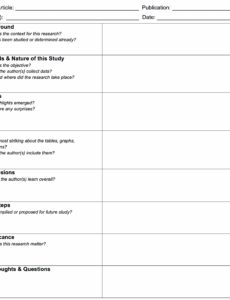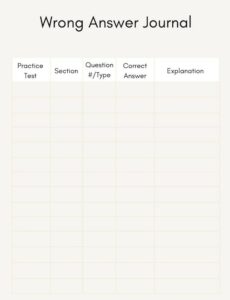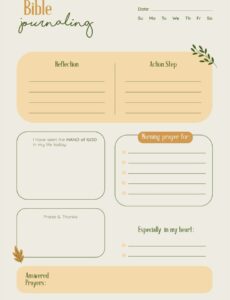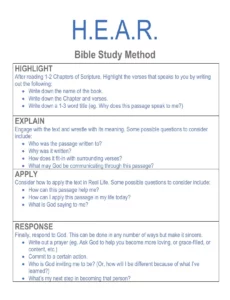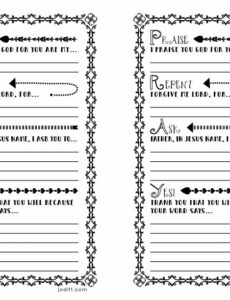Ever feel like you are just going through the motions with your health and wellness goals, without truly understanding what’s working or why? It’s a common experience. We often make efforts to eat better or exercise more, but without a clear system to track our progress, it’s hard to pinpoint what truly impacts our energy levels, mood, or physical achievements. Imagine having a personalized tool that helps you connect the dots between your daily choices and your overall well-being.
This is where a dedicated food and activity journal template becomes incredibly valuable. It’s more than just a place to jot down notes; it’s a powerful self-reflection tool that transforms vague intentions into actionable insights. By consistently recording what you consume and how you move, you unlock a deeper understanding of your body’s responses, paving the way for more informed decisions and sustainable habits. Let’s explore how you can leverage such a template to optimize your health journey.
The Undeniable Benefits of Consistent Tracking
Diving into the world of personal health tracking might seem like an extra chore, but the insights gained are truly transformative. When you consistently log your food intake and physical activities, you’re not just creating a record; you’re building a comprehensive picture of your daily habits. This clarity helps you identify patterns you might never have noticed, such as how certain foods affect your energy later in the day, or how consistent light activity contributes to better sleep. It’s like having a personal detective for your well-being, uncovering clues that lead to healthier choices.
Think about the last time you felt sluggish or had an unexplained dip in mood. Without a journal, it’s easy to dismiss these as random occurrences. However, a detailed entry about yesterday’s high-sugar meal or a particularly stressful day at work, coupled with inadequate sleep, can suddenly make perfect sense of today’s struggles. This cause-and-effect relationship becomes strikingly clear in a food and activity journal, allowing you to proactively adjust your diet or schedule to prevent future slumps.
Beyond identifying challenges, consistent tracking also highlights your successes. Perhaps you’ve been feeling more vibrant, but couldn’t quite put your finger on why. Looking back at your journal, you might discover you’ve increased your water intake, added more whole foods, or found a new form of exercise you truly enjoy. Recognizing these positive patterns reinforces good habits and provides a huge boost to your motivation, making it easier to stick with your routine and build momentum towards your health goals.

Ultimately, a dedicated journal empowers you to take control. It removes the guesswork from healthy living and replaces it with data-driven self-awareness. It moves you from simply reacting to your body’s signals to understanding and anticipating them, fostering a more harmonious relationship with your physical and mental health. This deep self-knowledge is the foundation for creating lasting, positive changes that truly align with your personal wellness aspirations.
Unlocking Key Personal Insights
- Discovering food sensitivities or intolerances you weren’t aware of.
- Identifying the types of activities that boost your mood and energy most effectively.
- Understanding the direct impact of sleep quality on your daily performance.
- Tracking progress towards fitness goals and celebrating small victories.
- Developing greater mindfulness around eating and movement, fostering a healthier relationship with your body.
Crafting Your Personalized Food and Activity Journal Template
Now that we’ve explored the powerful benefits, let’s talk about how to design a food and activity journal template that genuinely works for you. The key here is personalization. There’s no one-size-fits-all solution, as everyone’s goals and daily routines are unique. Your template should be a reflection of what you want to track and the specific insights you aim to gain. Start by considering what aspects of your health you’re most curious about or trying to improve.
A good starting point for any food and activity journal template involves the basics: date, time, and specific entries for both food and exercise. For food, you might want to record what you ate, the portion size, and how you felt afterwards (e.g., energized, sluggish, satisfied). For activity, note the type of exercise, duration, intensity, and again, your post-workout feelings. However, don’t stop there. Think about other factors that influence your well-being, such as hydration, sleep quality, stress levels, or even your overall mood. Adding these extra data points can paint a much richer picture.
Making your template easy to use is crucial for long-term adherence. If it feels like a monumental task every day, you’re less likely to stick with it. Consider whether a digital format (like a spreadsheet or an app) or a physical notebook suits you best. Digital templates offer convenience, searchability, and often automated calculations, while physical journals provide a more tactile, reflective experience. Choose the method that seamlessly integrates into your daily life and feels natural to use.
Don’t be afraid to evolve your template over time. As you start tracking, you might realize certain fields aren’t as helpful as you thought, or that you need to add new ones. Your journey with your food and activity journal is dynamic, and your template should be too. Experiment with different layouts, categories, and levels of detail until you find the perfect balance that provides meaningful insights without becoming overwhelming. This iterative process ensures your journal remains a valuable and relevant companion on your path to wellness.
- Daily Essentials: Date, day of the week, total sleep hours.
- Food Tracking: Each meal/snack with time, items consumed, portion size, and a brief note on how you felt (e.g., “full,” “satisfied,” “hungry later”).
- Hydration: Number of water glasses or total fluid intake.
- Activity Log: Type of exercise, duration, intensity level, and any notes on performance or discomfort.
- Mind & Mood: A simple mood tracker (e.g., 1-5 scale) and space for reflections on stress levels or general well-being.
- Other Notes: Space for miscellaneous observations like medication, supplements, or specific symptoms.
Embracing the habit of detailed self-observation through a journal is truly an act of self-care. It’s about more than just numbers and entries; it’s about fostering a deeper connection with your body’s signals and respecting its needs. This commitment to understanding your personal ecosystem allows you to make conscious choices that consistently support your health and happiness, leading to a life filled with greater vitality and purpose.
The journey to optimal health is unique for everyone, and having a personalized tool like a well-designed journal empowers you to navigate it with confidence and clarity. By consistently reflecting on your inputs and outputs, you build an invaluable repository of knowledge about yourself. This wisdom becomes your compass, guiding you toward habits and lifestyles that genuinely resonate with your well-being and help you thrive every single day.
